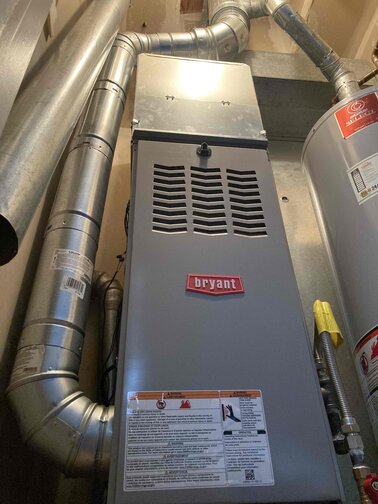Furnace issues can disrupt your home’s comfort and safety. Understanding common problems and how to address them is essential for every homeowner. We aim to equip you with the knowledge needed to identify and solve basic furnace problems.
Common Furnace Problems and Their Causes
Understanding common furnace problems and their causes is essential for proper furnace repair. One frequent issue is a malfunctioning thermostat. When the thermostat doesn’t work correctly, it can lead to inconsistent temperature control or the furnace not turning on at all. This problem is often due to faulty wiring or dead batteries.
Another prevalent problem is clogged or dirty filters. Dirty filters restrict airflow, causing the furnace to work harder to circulate air. This added strain can lead to overheating and even a system shutdown. Replacing or cleaning filters regularly can prevent this issue.
Mechanical wear and tear is also a common cause of furnace problems. Components like belts, bearings, and motors can wear out over time, reducing efficiency and causing noise. Regular maintenance helps identify worn parts before they fail completely.
Pilot and ignition control issues are other typical furnace problems. If the pilot light or electronic ignition system fails, the furnace won’t heat properly. This can be due to a dirty sensor, a faulty ignition switch, or issues with the gas supply. Prompt attention to these problems ensures the furnace functions safely and efficiently.
Troubleshooting Furnace Ignition Issues
Furnace ignition issues are common and can often be resolved with some basic troubleshooting. One of the first steps is to check the thermostat settings. Ensure that the thermostat is set to “heat” and at the desired temperature. Sometimes, thermostat settings can be accidentally changed.
If the thermostat settings are correct, the next step is to inspect the pilot light. For older furnaces with a standing pilot light, ensure the pilot is lit. If it’s out, try relighting it according to the furnace manufacturer’s instructions. If the pilot light frequently goes out, there may be an issue with the thermocouple or gas supply.
Inspecting the ignition switch is another important step. Modern furnaces often use an electronic ignition system. If your furnace has an electronic ignition, listen for a clicking sound when the furnace attempts to ignite. If you don’t hear this sound, the ignition system may need repair or replacement.
Checking the furnace filter is also vital. A clogged filter can prevent the ignition system from working correctly. Replace the filter if it is dirty, and see if the furnace ignites properly.
Maintenance Tips to Prevent Furnace Problems
Preventing furnace problems is easier with regular maintenance. By following a few simple steps, you can extend the life of your furnace and improve its efficiency. Routine care ensures that small issues don’t turn into major repairs.
1. Change the Air Filters Regularly: Dirty filters reduce airflow and can cause the furnace to overheat. Replacing them every 1-3 months, depending on usage, keeps the system running smoothly.
2. Inspect the Thermostat: Ensure the thermostat is working correctly. Replace old batteries and make sure the settings are correct. A malfunctioning thermostat can cause the furnace to operate irregularly.
3. Clean Vents and Ducts: Blocked vents and ducts hinder airflow. Regularly clean them to ensure proper air distribution throughout your home. Ensure vents are open and unobstructed by furniture or other objects.
4. Check the Blower Motor: The blower motor circulates air through your home. Ensure it is clean and free of debris which can cause overheating. Lubricate the motor bearings if necessary.
5. Schedule Professional Maintenance: An annual inspection by our professionals can catch potential problems early. Our technicians perform thorough checks, clean components, and make necessary adjustments to ensure your furnace operates efficiently.
When to Call a Professional for Furnace Repair
Knowing when to call a professional for furnace repair is crucial for your safety and comfort. Some signs indicate that it’s time to seek expert help to prevent further damage and ensure efficient operation.
1. Frequent Cycling: If your furnace turns on and off frequently, it might signal an issue with the thermostat or airflow. Continuous cycling strains the system, leading to wear and tear.
2. Unusual Noises: Strange sounds such as banging, squealing, or rattling can indicate mechanical problems. These noises often stem from loose or broken components requiring immediate attention.
3. Inconsistent Heating: Uneven temperatures or cold spots in your home can be a sign of issues with the ductwork or the furnace itself. Professional assessment can pinpoint and resolve the problem.
4. High Energy Bills: A sudden spike in your energy bills could mean your furnace is working harder due to underlying issues. An inefficient furnace consumes more energy, costing you more in the long run.
5. Pilot Light Issues: A yellow or flickering pilot light may indicate a problem with the gas supply or combustion. A blue flame indicates proper operation, whereas other colors may signal a safety concern.
Conclusion
Maintaining a well-functioning furnace is essential for keeping your home warm and comfortable. Understanding common furnace problems, taking preventive measures, and knowing when to call a professional can save you time and money in the long run. Our aim is to provide you with the knowledge to handle minor issues and recognize when professional help is needed.
We at Fix It 24/7 Air Conditioning are here to assist you with all your furnace repair needs. Our experienced technicians are ready to offer reliable and efficient solutions. Contact us today to ensure your furnace is in top condition for the colder months ahead!

